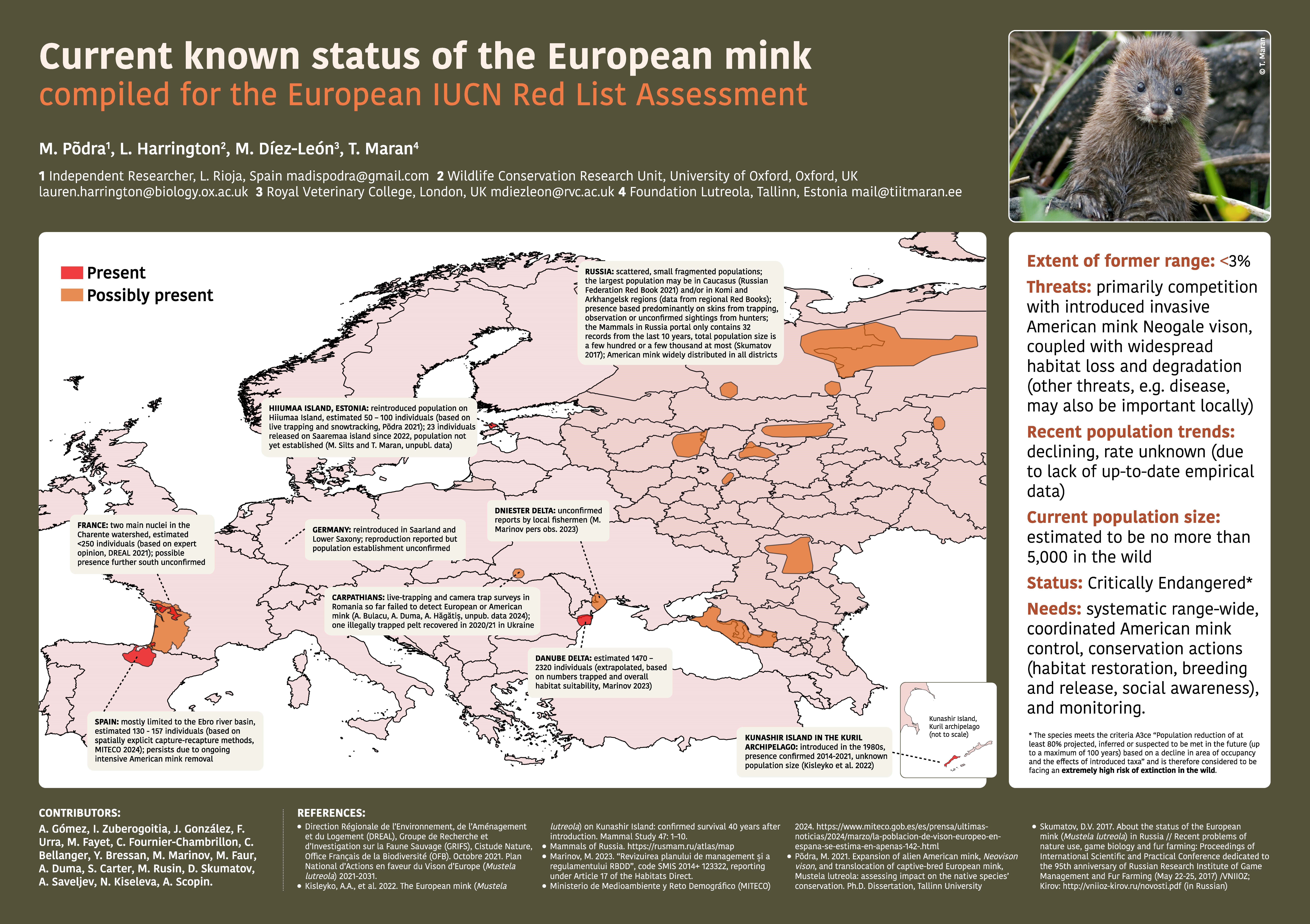CONSERVATION CONTEXT
European mink (Mustela lutreola) are a small, little-known species, currently teetering on the edge of extinction. Recent estimates suggest that the species persists in less than 3% of its former range across Europe and European Russia, and numbers no more than 5,000 individuals. Most extant populations comprise fewer than 250 individuals and there is considerable uncertainty around the status of even the largest populations. The primary threat to the species is interspecific aggression from the introduced invasive American mink (Neogale vison); widespread habitat loss and degradation also played a role in the species decline and likely present a threat locally.

Both species are small (approximately 1 kg), solitary, semi-aquatic, generalist species that occupy homes ranges along the banks of rivers, lakes, and other wetland habitats. Invasive American mink are slightly larger, slightly more aggressive, and slightly more adaptable than their native European counterparts, and tend to out-compete European mink wherever they both occur. American mink were introduced to Europe via the fur farming trade, and now occur as free-living populations across Eurasia (and in parts of South America).
WILDCRU APPROACH
WildCRU researchers have worked with partners to study the ecology and behaviour of both species in 6 European countries and in Patagonia, South America. Our work helped understand the mechanism of decline of European mink, contributed to knowledge of effective management strategies for American mink, and provided insight into the natural history, reproductive strategies, and behavioural ecology of both species. We continue to use our understanding of American mink to provide a model species for broader ecological and conservation research questions (for example, to test potential welfare metrics) and to advise on, and contribute to, management and policy actions across Europe.
MINK RESEARCH AND CONSERVATION IMPACT HIGHLIGHTS
Contributed to the 2024 European mink IUCN Red List assessment update
Led the American mink risk assessment, used by the European Commission to support listing on the EU Invasive Alien Species Regulations
Advised on the monitoring and management of American mink at the Life Atias workshop, Greece
WildCRU has one long-running programme focused on mink research and conservation, and one programme that involves research on mink as a model species:
Key WildCRU publications relating to mink:
Mink on the brink: comparing survey methods for detecting a critically endangered carnivore, the European mink Mustela lutreola
Chapter 6: Biology, ecology and reproduction of American mink, Neovison vison, on lowland farmland
Wild American mink (Neovison vison) may pose a COVID-19 threat
European Mink Mustela lutreola Linnaeus
Current status of American mink Neovison vison in Great Britain: a review of the evidence for a population decline
Chapter 17: European mink – restoration attempts for a species on the brink of extinction
Mink on the brink: comparing survey methods for detecting a critically endangered carnivore, the European mink Mustela lutreola
Monitoring rare and elusive species is critical in guiding appropriate conservation management measures. Mammalian carnivores are challenging to monitor directly, due to their generally nocturnal and solitary lifestyle, and relatively large home ranges. The European mink Mustela lutreola is a critically endangered, small, semi-aquatic carnivore and is one of the most threatened mammal species in Europe. In northern Spain, the European mink population is monitored regionally using different methods and approaches, making assessment of national population status difficult. There is an urgent need to 1) assess the efficacy of survey methods and 2) identify a standard monitoring methodology that can be deployed rapidly and inexpensively over large areas of the mink’s range. We deployed four methods—camera trapping, hair tubes, live trapping, and environmental DNA (eDNA) from water samples—to compare the probability of detecting European mink when present at 25 sampling sites within five 10 × 10 km2, and the economic cost and time required for each method. All four methods successfully detected European mink but the probability of detection varied by method. Camera trapping and hair tubes had the highest probability of detection; however, eDNA and live trapping detected mink in one 10 × 10 km2 where the latter two methods did not. For future European mink monitoring programs, we recommend a combination of at least two methods and suggest that camera traps or hair tubes are combined with live trapping or eDNA (depending on the scale and aims of the study), to gather critical information on distribution, occupancy and conservation status.